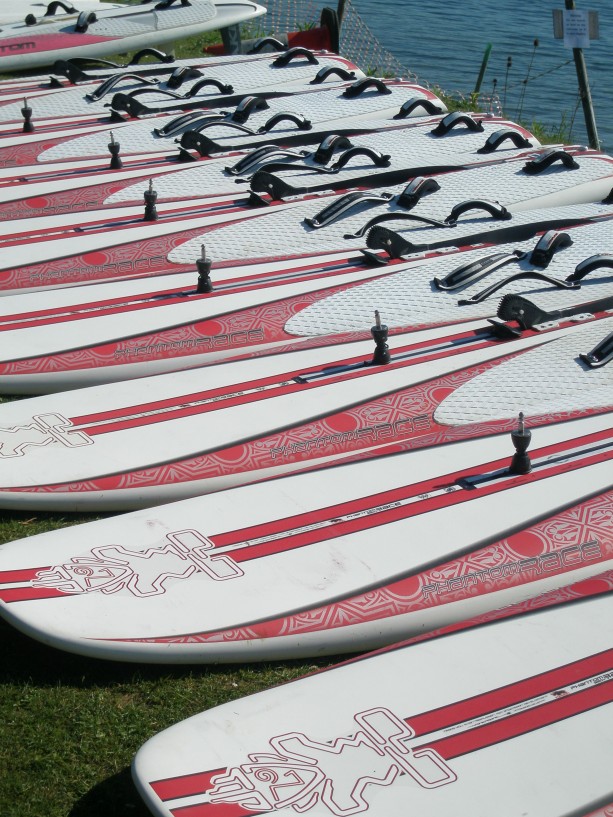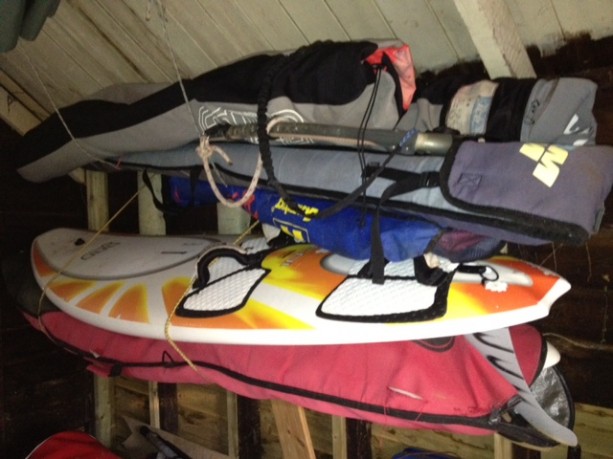Winter is coming and whilst many continue on in the strong winter winds for some of us, it means that it’s time to put our kit away until the lighter nights and warmer temperatures roll round again. So with packing up for the winter in mind the RYA’s Laurence West shares a few top tips on storing your kit.

It may be tempting to just leave our windsurfing kit in the shed/garage/corner of the garden in the same state that it came back from our last sailing session; however, this might not be a good idea if we want it to be usable and ready for the first trip out in the new season.
The age-old enemy is salt, but there are a few other things that could damage or destroy our valuable equipment before it sees the light of day again, for example, wildlife, which might take a liking to our pride and joy and either take up residence in it or find it a valuable food source over the long winter nights!
So if you want to preserve your windsurfing equipment in readiness for the next sailing session, here are just a few top tips to bear in mind.
Let’s start with boards. If you haven’t already, give it a good hosing down with fresh water. Pay particular attention to the foot straps and their insertion points, and mast track. It mightn’t be a bad idea to remove the straps altogether and hose out the fittings. Allow the straps to dry in their natural position before reattaching them. Remove the fin(s) if it’s not out already, and do the same thing with the fin box and fittings.
Once dry, put the board back in its bag, but not before you’ve attended to the zip on the bag. Because the zip is likely to have had salty water over it, once it dries out, salt deposits will cause the zip slider to become sticky or eventually jam completely. Top tip; use malt vinegar to remove these deposits before they become critical. Prior to that, a good dousing in fresh water will help the build-up in the first place. Often perfectly good, expensive bags can be rendered useless because of jammed zips.
Sail’s next. As with boards, a good hosing down with fresh water over the entire sail is needed, paying particular attention to batten pockets, cringles/rollers and seams. Monofilm is surprisingly robust stuff being non-absorbent, but the thread used at seams and any Dacron on the sail is less durable, so removing the salt is key.
Once washed, let the sail dry completely on both sides before rolling it carefully without creasing and replacing it in its bag. Top tip here, zip up the bag to prevent small rodents taking up residence over their hibernation period. Place the sail in a cool, dry storage area until it is needed.
On to masts. Lots of fresh water will be the best idea, paying particular attention to removing all sand and grit from inside both sections and around the ferrule. Allow to dry and re pack in their bag.
Now let’s look at the universal joint (UJ), extension and mast base. Again; lots of fresh water is a good starting point. Don’t forget to give the UJ a good check for damage/wear and perhaps consider replacing the rope completely, rather than just putting a knot above the obvious wear.

As for booms, dismantle the sections as far as possible and hose out to remove salt and grit (can you spot the theme emerging here!). Check and replace all ropes and don’t forget to have a good look at the harness lines. Sand gets into the plastic sleeve and acts as a grinding paste on the rope of the harness line. It’s only a matter of time before it snaps, so if in doubt, consider replacing the lines.
Finally let’s look at your wetsuit. Why not give it a treat by giving it a good wash using specialist wetsuit shampoo or if that’s not to hand, a baby shampoo will do. Make sure it’s rinsed thoroughly afterwards to remove all the suds. A cycle thorough a washing machine is often tempting, but even the gentlest programme could be a bit too brutal for delicate suits, so risk upsetting your loved ones and use the bath.
Do the same for your harness and wetsuit boots at the same time. Allow the suit to dry flat, or even better, on a shaped hanger; not a wire one as these put a lot of strain on the suit and will pull it out of shape round the shoulders. Store it flat or hang it up in a cool, dry place, but avoid any creases.
At this point, it’s probably a good idea to attend to any nicks or tears that have been picked up over the season. Lubing the zip with a specialist lube or beeswax stick is also recommended. A lot of people are convinced that their suits shrink over the winter, but it’s most likely that the excesses of the festive season cause the apparent ‘snugness’ in the new season and not neoprene shrinkage!
By following these few simple steps, your kit will be ready for the first blowy day of spring, and there won’t be a mad panic to wrestle your board out of its bag or find a family of mice have taken a liking to your favourite sail.
Happy cleaning!





